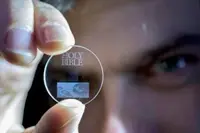 Scientists at the University of Southampton have made a major step forward in the development of digital data storage that is capable of surviving for billions of years.
Scientists at the University of Southampton have made a major step forward in the development of digital data storage that is capable of surviving for billions of years.
Using nanostructured glass, scientists from the University’s Optoelectronics Research Centre (ORC) have developed the recording and retrieval processes of five dimensional (5D) digital data by femtosecond laser writing. The ultrafast laser produces extremely short, intense pulses of light and writes the files in three layers of nanostructured dots separated by 5µm.
The data is recorded via self-assembled nanostructures created in fused quartz. The five dimensional recording of information is achieved through the size and orientation of the nanostructures as well as the three dimensional positions of the nanodots.
The self-assembled nanostructures change the way light travels through glass, modifying polarisation of light that can then be read by combination of optical microscope and a polariser, similar to that found in Polaroid sunglasses.
The storage allows unprecedented properties including 360TBytes disc data capacity, thermal stability up to 1000°C and virtually unlimited lifetime at room temperature - 13.8billion years at 190°C. The researchers claim that this is a stable and safe form of portable memory that could be useful for organisations with big archives, such as national archives, museums and libraries, to preserve their information and records.
Major documents from human history such as Universal Declaration of Human Rights, Newton’s Opticks, Magna Carta and Kings James Bible, have been saved via this method as digital copies that could survive the human race.
Professor Peter Kazansky, from the ORC, says: “It is thrilling to think that we have created the technology to preserve documents and information and store it in space for future generations. This technology can secure the last evidence of our civilisation: all we’ve learnt will not be forgotten.”
The team are now looking for industry partners to further develop and commercialise this technology.
Author
Tom Austin-Morgan
Source: www.newelectronics.co.uk

